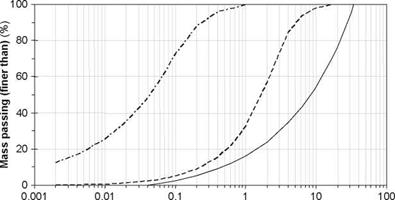Porous Media
Roads and embankments are made up by a finite number of layers. They can be considered as porous media that consist of aggregates or granular materials and soils through which fluid can flow. The road layer can appear either unbound or stabilized with bitumen or cement to increase their strength. In roads, most surface layers have very low permeability properties and can often be treated as impervious, at least in roads in good conditions. Usually, all others layers are permeable. The fluid flow behaviour of the different layers is strongly dependent on their particle size distribution and pore space openings.
The grain size distribution of unbound aggregates or soils is determined by either sieving or by the rate of settlement in an aqueous suspension. Table 2.1 shows the classification of soil particles or aggregates by size according to EN ISO 146881 (CEN, 2002). The distribution of coarse and very coarse soil fractions can be estimated through sieving but the size distribution of the fine soil particles needs to be estimated in a settlement rate test (hydrometer test).
|
|||||||||||||||||||||||||||||||||||||||||||||||||||||||||||||||||||||
|
Based on the grain size distribution curve three parameters are frequently determined, that is the effective size D10, the uniformity coefficient Cu and coefficient of gradation Cc. The parameter D10 is the diameter of the largest particle that can be found in the smallest 10% of the particle-size distribution curve. The uniformity coefficient Cu and coefficient of gradation Cc are given as:
where D30 and D60 are the diameter on the particle-size distribution curve, similar to D10 but corresponding to 30% and 60% finest fractions respectively. These three parameters are sometimes used to estimate the saturated coefficient of permeability of some types of soils.







Leave a reply